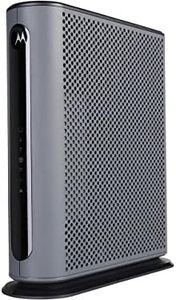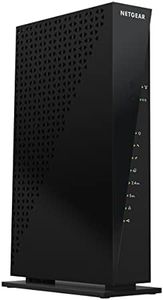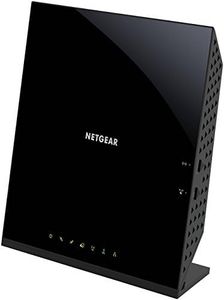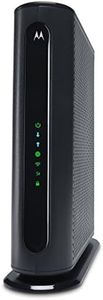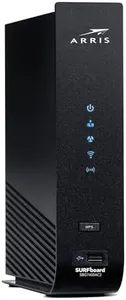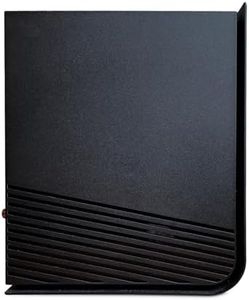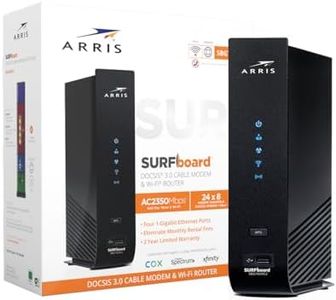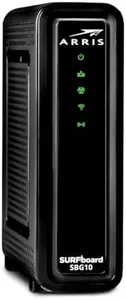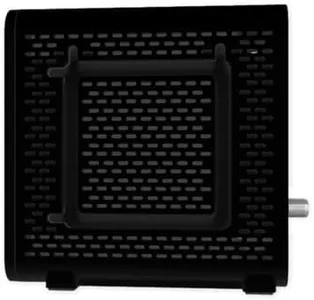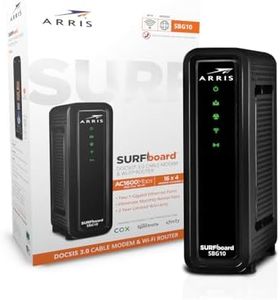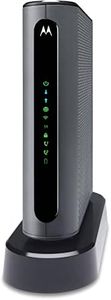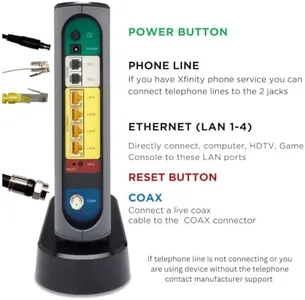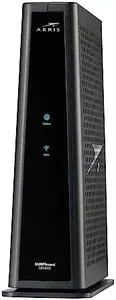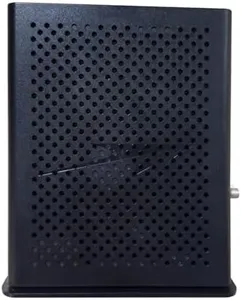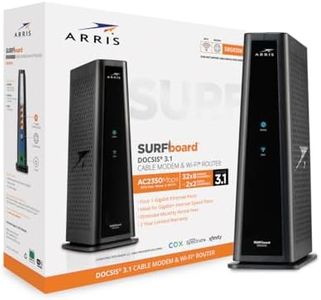10 Best Modem Router Combinations 2025 in the United States
Winner
NETGEAR Nighthawk Modem Router Combo (CAX30) DOCSIS 3.1 Cable Modem and WiFi 6 Router - AX2700 2.7 Gbps - Compatible with Xfinity, Spectrum, Cox, and More - Gigabit Wireless Internet
The NETGEAR Nighthawk CAX30 is a solid option if you have a cable internet provider such as Xfinity, Spectrum, or Cox and want to combine your modem and router into one device. It supports fast internet speeds up to 2Gbps, thanks to DOCSIS 3.1 technology and WiFi 6 (802.11ax) standard, which helps deliver wireless speeds up to 2.7Gbps on two bands (2.4GHz and 5GHz). This setup is suitable for medium-sized homes, covering around 2,000 square feet and supporting up to 25 devices at once, making it good for streaming, gaming, and general browsing. It also offers four Gigabit Ethernet ports to connect wired devices like computers or gaming consoles, plus a USB 3.0 port for extra storage or media sharing.
Most important from
556 reviews
NETGEAR Nighthawk Cable Modem with Built-in WiFi 6 Router (CAX80) - Compatible All Major Providers incl. Xfinity, Spectrum, Cox | Plans Up to 6Gbps AX6000 speed DOCSIS 3.1, Black
The NETGEAR Nighthawk CAX80 is a solid choice if you have a cable internet plan from providers like Xfinity, Spectrum, or Cox, especially if you’re aiming for fast speeds up to 6Gbps. It supports the latest DOCSIS 3.1 technology and Wi-Fi 6, which means faster and more reliable wireless connections. The modem-router combo offers dual-band Wi-Fi with a coverage area around 2,500 sq. ft., which should be enough for most homes, and can handle about 30 devices at once without much slowdown.
Most important from
3443 reviews
NETGEAR Orbi Modem Router Combo (CBK752) DOCSIS 3.1 Cable Modem and WiFi 6 Mesh Router – AX4200 4.2Gbps Wireless Speed – Compatible with Xfinity, Spectrum, Cox, More – Covers 5,000 sq.ft., 40 Devices
The NETGEAR Orbi Modem Router Combo (CBK752) is designed to deliver fast and reliable internet for homes with multiple devices, supporting the latest DOCSIS 3.1 standard which works well with most cable providers like Xfinity, Spectrum, and Cox. It can handle internet plans up to 4Gbps, though exact speeds depend on your provider. The device uses WiFi 6 technology (802.11ax) with tri-band support, offering AX4200 speeds that are great for smooth streaming, gaming, and video calls. The combo covers up to 5,000 sq.ft., suitable for medium to large homes, and you can add satellites to extend coverage further if needed.
Most important from
1852 reviews
Top 10 Best Modem Router Combinations 2025 in the United States
Winner
NETGEAR Nighthawk Modem Router Combo (CAX30) DOCSIS 3.1 Cable Modem and WiFi 6 Router - AX2700 2.7 Gbps - Compatible with Xfinity, Spectrum, Cox, and More - Gigabit Wireless Internet
NETGEAR Nighthawk Modem Router Combo (CAX30) DOCSIS 3.1 Cable Modem and WiFi 6 Router - AX2700 2.7 Gbps - Compatible with Xfinity, Spectrum, Cox, and More - Gigabit Wireless Internet
Chosen by 1437 this week
NETGEAR Nighthawk Cable Modem with Built-in WiFi 6 Router (CAX80) - Compatible All Major Providers incl. Xfinity, Spectrum, Cox | Plans Up to 6Gbps AX6000 speed DOCSIS 3.1, Black
NETGEAR Nighthawk Cable Modem with Built-in WiFi 6 Router (CAX80) - Compatible All Major Providers incl. Xfinity, Spectrum, Cox | Plans Up to 6Gbps AX6000 speed DOCSIS 3.1, Black
NETGEAR Orbi Modem Router Combo (CBK752) DOCSIS 3.1 Cable Modem and WiFi 6 Mesh Router – AX4200 4.2Gbps Wireless Speed – Compatible with Xfinity, Spectrum, Cox, More – Covers 5,000 sq.ft., 40 Devices
NETGEAR Orbi Modem Router Combo (CBK752) DOCSIS 3.1 Cable Modem and WiFi 6 Mesh Router – AX4200 4.2Gbps Wireless Speed – Compatible with Xfinity, Spectrum, Cox, More – Covers 5,000 sq.ft., 40 Devices
NETGEAR Nighthawk Modem Router Combo C7000-Compatible with Cable Providers Including Xfinity by Comcast, Spectrum, Cox,Plans Up to 800Mbps | AC1900 WiFi Speed | DOCSIS 3.0
NETGEAR Nighthawk Modem Router Combo C7000-Compatible with Cable Providers Including Xfinity by Comcast, Spectrum, Cox,Plans Up to 800Mbps | AC1900 WiFi Speed | DOCSIS 3.0
NETGEAR Nighthawk Modem Router Combo (CAX30S) DOCSIS 3.1 Cable Modem and WiFi 6 Router - AX2700 6.0 Gbps - Compatible with Xfinity, Spectrum, Cox, and More - Gigabit Wireless Internet - NETGEAR Armor
NETGEAR Nighthawk Modem Router Combo (CAX30S) DOCSIS 3.1 Cable Modem and WiFi 6 Router - AX2700 6.0 Gbps - Compatible with Xfinity, Spectrum, Cox, and More - Gigabit Wireless Internet - NETGEAR Armor
Motorola MG7700 Modem WiFi Router Combo with Power Boost | Approved by Comcast Xfinity, Cox and Spectrum | for Cable Plans Up to 800 Mbps | DOCSIS 3.0 + Gigabit Router
Motorola MG7700 Modem WiFi Router Combo with Power Boost | Approved by Comcast Xfinity, Cox and Spectrum | for Cable Plans Up to 800 Mbps | DOCSIS 3.0 + Gigabit Router
Motorola MT7711 24X8 Cable Modem/Router with Two Phone Ports, DOCSIS 3.0 Modem, and AC1900 Dual Band WiFi Gigabit Router, for Comcast XFINITY Internet and Voice
Motorola MT7711 24X8 Cable Modem/Router with Two Phone Ports, DOCSIS 3.0 Modem, and AC1900 Dual Band WiFi Gigabit Router, for Comcast XFINITY Internet and Voice
ARRIS (SBG8300) - Cable Modem Router Combo - Fast DOCSIS 3.1 Gigabit & AC2350 WiFi ,Comcast Xfinity, Cox, Spectrum & more, 1 Gbps Max Internet Speeds , 4 OFDM Channels
ARRIS (SBG8300) - Cable Modem Router Combo - Fast DOCSIS 3.1 Gigabit & AC2350 WiFi ,Comcast Xfinity, Cox, Spectrum & more, 1 Gbps Max Internet Speeds , 4 OFDM Channels
Recommended lists
Our technology thoroughly searches through the online shopping world, reviewing hundreds of sites. We then process and analyze this information, updating in real-time to bring you the latest top-rated products. This way, you always get the best and most current options available.

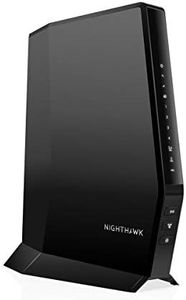
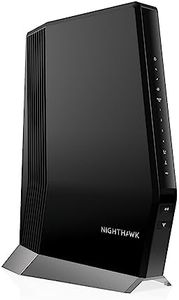
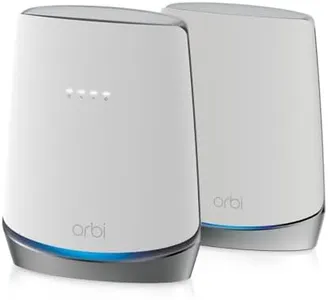
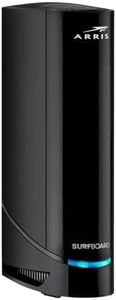


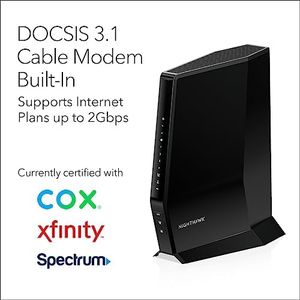

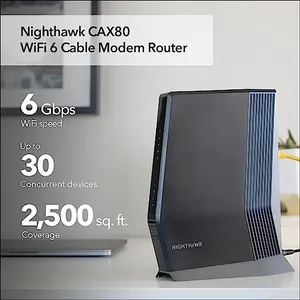
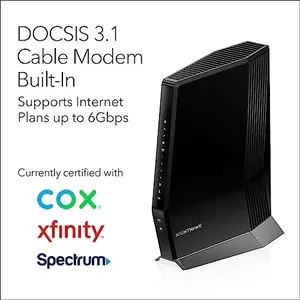





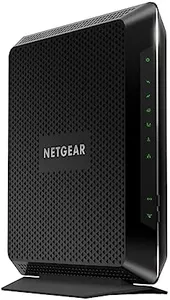
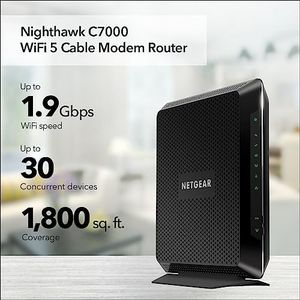
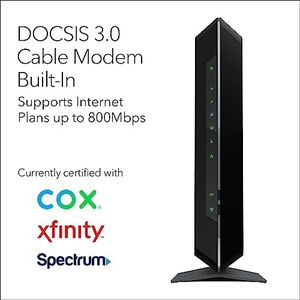

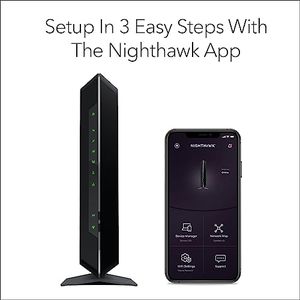
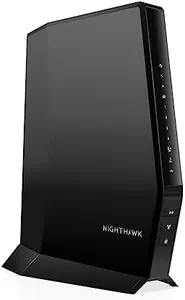
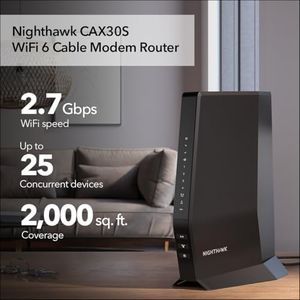

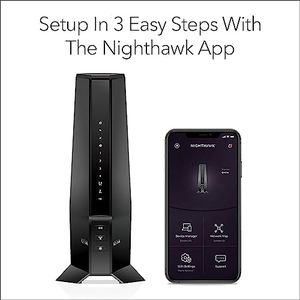
![ARRIS (SBG7600AC2) - Cable Modem Router Combo - DOCSIS 3.0 & AC2350 WiFi, for Comcast Xfinity, Cox, check with ISP for compatibility [Not for Spectrum] Four 1 Gbps Ports , 800 Mbps Max Internet Speeds](https://images-proxy.bestreviews.guide/rtdKhSDGAszn-IsTRETxLvbwsAM=/0x300/https://m.media-amazon.com/images/I/41Uoor5u5sL._AC_CX679_.jpg)
